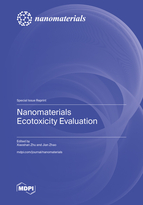Nanomaterials Ecotoxicity Evaluation
A special issue of Nanomaterials (ISSN 2079-4991). This special issue belongs to the section "Environmental Nanoscience and Nanotechnology".
Deadline for manuscript submissions: closed (28 February 2023) | Viewed by 29394
Special Issue Editors
Interests: marine ecotoxicology of emerging chemicals, especially the fate, transport, transformation, bioaccumulation and toxicity of manufactured nanomaterials, plastic particles, POPs and heavy metals, etc. in an aquatic environment; ecology and ecosystem health assessment; new methods and technologies for marine ecological monitoring
Interests: environmental behaviors of engineered nanoparticles and microplastics; toxicity of nanoplastics in aquatic environments; application of nanotechnology in environments
Special Issue Information
Dear Colleagues,
Nanotechnology has made enormous progress over the last few decades, and the current use of nanomaterials is rapidly increasing. As a result, the continuous release of nanomaterials to air, water, and soil has raised concerns about possible adverse consequences for environmental and human health. This Special Issue pays close attention to the evaluation of nanomaterials’ ecotoxicity associated with the occurrences, behavior, fate, and bioavailability of nanomaterials. Such an evaluation would be critical for scientists, legislators, business leaders, and the public to understand and develop effective solutions toward the potential impacts of nanomaterials. We herein invite submissions presenting new and original research on the following topics including but not limited to:
- Toxicity and ecological effects of nanomaterials;
- Bioconcentration and bioaccumulation of nanomaterials in aquatic and terrestrial organisms;
- Trophic transfer and biomagnification of nanomaterials in aquatic and terrestrial ecosystems;
- Transport and transformation of nanomaterials in air, water, and soil environments;
- Environmental and health risk assessment of nanomaterials.
Research articles, letters, reviews, as well as perspective views are all welcome. We look forward to your submissions.
Dr. Xiaoshan Zhu
Dr. Jian Zhao
Guest Editors
Manuscript Submission Information
Manuscripts should be submitted online at www.mdpi.com by registering and logging in to this website. Once you are registered, click here to go to the submission form. Manuscripts can be submitted until the deadline. All submissions that pass pre-check are peer-reviewed. Accepted papers will be published continuously in the journal (as soon as accepted) and will be listed together on the special issue website. Research articles, review articles as well as short communications are invited. For planned papers, a title and short abstract (about 100 words) can be sent to the Editorial Office for announcement on this website.
Submitted manuscripts should not have been published previously, nor be under consideration for publication elsewhere (except conference proceedings papers). All manuscripts are thoroughly refereed through a single-blind peer-review process. A guide for authors and other relevant information for submission of manuscripts is available on the Instructions for Authors page. Nanomaterials is an international peer-reviewed open access semimonthly journal published by MDPI.
Please visit the Instructions for Authors page before submitting a manuscript. The Article Processing Charge (APC) for publication in this open access journal is 2900 CHF (Swiss Francs). Submitted papers should be well formatted and use good English. Authors may use MDPI's English editing service prior to publication or during author revisions.
Keywords
- Nanoparticles (nanoplastics)
- Engineered nanomaterials
- Ecotoxicity
- Bioconcentration and bioaccumulation
- Trophic transfer
- Transport and transformation
- Risk assessment
- Air, water, and soil environment








